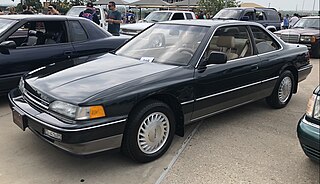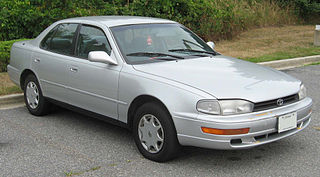
The Lexus GS is an executive car manufactured and marketed by Lexus across four generations — launched in 1991 as the Toyota Aristo in Japan and as the Lexus GS for markets outside the Japanese market beginning in February 1993. It continued with the Toyota Aristo name for the Japanese market until January 2005.

The Toyota Camry is an automobile sold internationally by the Japanese auto manufacturer Toyota since 1982, spanning multiple generations. Originally compact in size (narrow-body), the Camry has grown since the 1990s to fit the mid-size classification (wide-body)—although the two widths co-existed in that decade. Since the release of the wide-bodied versions, Camry has been extolled by Toyota as the firm's second "world car" after the Corolla. As of 2022, the Camry is positioned above the Corolla and below the Avalon or Crown in several markets.

The Lexus IS is a compact executive car sold by Lexus, a luxury division of Toyota, since 1998. The IS was originally sold under the Toyota Altezza nameplate in Japan from 1998. The IS was introduced as an entry-level sport model positioned below the ES in the Lexus lineup.

The Toyota Corona is an automobile manufactured by the Japanese automaker Toyota across eleven generations between 1957 and 2001. On launch, the Corona was Toyota's second-highest product in their range, just below the Crown. The Corona was marketed in the JDM at Toyota's Toyopet Store dealership channels, and the Corona was one of Toyota's first models exported to other global markets, followed by the smaller Toyota Corolla.

The Toyota Soarer is a personal luxury GT coupé produced from 1981 to 2005 by Toyota and sold in Japan. It was available at both Japanese Toyota dealerships called Toyota Store and Toyopet Store, and it debuted with the Z10 series, replacing the Toyopet Store exclusive Mark II coupé, the Toyota Auto Store exclusive Chaser coupé, and both the Toyota Store exclusive Crown coupé and Carina coupé.

The Acura Legend is a mid-size luxury car manufactured by Honda from Japan. It was sold in the U.S. and Canada under Honda's luxury brand, Acura, from 1985 until 1995. It was the first flagship sedan sold under the Acura nameplate, until being renamed in 1996 as the Acura 3.5RL. The 3.5RL was the North American version of the KA9 series Honda Legend.

The Lincoln LS is a four-door, five-passenger luxury sedan manufactured and marketed by Ford's Lincoln division over a single generation from 1999 until 2006. Introduced in June 1999 for the 2000 model year, the LS featured rear-wheel drive and near 50/50 weight distribution and was available with a V8 or V6, the latter initially offered with a manual transmission. The LS aimed to provide a blend of luxury and sport to attract a new generation of buyers to the Lincoln brand.

The Lexus LS is a series of full-size luxury sedans that have served as the flagship model of Lexus, the luxury division of Toyota, since 1989. For the first four generations, all LS models featured V8 engines and were predominantly rear-wheel-drive. In the fourth generation, Lexus offered all-wheel-drive, hybrid, and long-wheelbase variants. The fifth generation changed to using a V6 engine with no V8 option, and only one length was offered.

The Toyota Century is a lineup of full-size luxury cars and limousines produced mainly for the Japanese market, serving as Toyota's flagship car within Japan; globally the unrelated Lexus LS series is Toyota's flagship luxury model. Production of the Century began in 1967, and the model received only minor changes until redesigns in 1997 and 2018.

The Toyota Mark II is a compact, later mid-size sedan manufactured and marketed in Japan by Toyota between 1968 and 2004. Prior to 1972, the model was marketed as the Toyota Corona Mark II. In most export markets, Toyota marketed the vehicle as the Toyota Cressida between 1976 and 1992 across four generations. Toyota replaced the rear-wheel-drive Cressida in North America with the front-wheel-drive Avalon. Every Mark II and Cressida was manufactured at the Motomachi plant at Toyota, Aichi, Japan from September 1968 to October 1993, and later at Toyota Motor Kyushu's Miyata plant from December 1992 to October 2000, with some models also assembled in Jakarta, Indonesia and Parañaque, Philippines as the Cressida.

The Toyota Carina is an automobile which was manufactured by Toyota from December 1970 to December 2001. It was introduced as a sedan counterpart of the Celica, with which it originally shared a platform. Later, it was realigned to the Corona platform, but retained its performance image, with distinctive bodywork and interior — aimed at the youth market and remaining exclusive to Japanese Toyota dealerships Toyota Store. It was replaced in Japan by the Toyota Allion in 2001 and succeeded in Europe by the Toyota Avensis.

The Toyota Tercel is a subcompact car manufactured by Toyota from 1978 until 1999 across five generations, in five body configurations sized between the Corolla and the Starlet. Manufactured at the Takaoka plant in Toyota City, Japan, and sharing its platform with the Cynos and the Starlet, the Tercel was marketed variously as the Toyota Corolla II—sold at Toyota Japanese dealerships called Toyota Corolla Stores—and was replaced by the Platz in 1999. It was also known as the Toyota Corsa and sold at Toyopet Store locations. Starting with the second generation, the Tercel dealership network was changed to Vista Store, as its badge engineered sibling, the Corolla II, was exclusive to Corolla Store locations.

The Toyota Caldina is an automobile manufactured by Toyota for the Japanese market from 1992 to 2007. It replaced the Corona and Carina wagons, and was sold at Toyota Store and Toyopet Store locations in Japan. While the Caldina has never been officially exported by Toyota, its All-Trac 4WD capability and large capacity have made it a popular grey import in Australia, New Zealand, Russia and many South American countries. When it was discontinued in 2007, the T270 series Avensis wagon/estate assumed its market position.

The Toyota Mark X is a mid-size car manufactured by Toyota between 2004 and 2019, and was primarily aimed at the Japanese market. The Mark X was introduced in 2004 and is the successor to the Mark II which was first introduced in 1968, and was known in the North American market as the Corona Mark II starting in 1972, and renamed the Cressida from 1977 to 1992.

The Toyota Camry (XV10) is a mid-size car that was produced by Toyota between 1991 and 1996 in Japan and North America, and 1993 and 1997 in Australia. The XV10 series represented the third generation of the Toyota Camry in all markets outside Japan, which followed a different generational lineage. The XV10 Camry range is split into different model codes indicative of the engine. Four-cylinder models use the SXV10/SDV10 codes, with VCV10 designating the six-cylinder versions, and MCV10 the later six-cylinder cars in North America only.

The Toyota Progrès is a mid-size luxury sedan which was sold in Japan from May 1998 to June 2007, replacing the Toyota Corona EXiV. The Progrès included 2.5 L or 3.0 L JZ inline 6-cylinder engines with VVT-i. Since April 2001, the Progrès used 1JZ-FSE and 2JZ-FSE direct injection (D4) engines. The versions with a 1JZ engine were called NC250, and those with a 2JZ engine NC300. It was exclusive to Toyota Japan dealerships Toyopet Store, while its twin the Brevis was exclusive to Toyota Store locations, and shared a marketing approach used on the Toyota Vista Store alternative, called the Toyota Verossa. The width and engine displacement exceed Japanese Government regulations concerning exterior dimensions and engine displacement, and therefore it classified in the larger "passenger car" tax bracket. Two engine sizes were offered to allow Japanese buyers which annual road tax they were willing to pay; the larger engine did offer higher levels of standard equipment and luxury features.
The Toyota N platform is a car platform for executive cars from Toyota, introduced in 2003. It is often called "Mark X platform" and "Crown platform", after its core uses, and, less frequently, "Lexus GS platform". It is used on a variety of sizes of rear- and all-wheel drive automobiles, ranging from compact to full-sized executive.

The Corolla E100 was the seventh generation of cars sold by Toyota under the Corolla nameplate. This generation of Corolla was larger, heavier, and visually more aerodynamic than the model it replaced. With its 2,465 mm (97.0 in) wheelbase, the Corolla had moved into the compact size class once occupied by the Corona and Camry. The Corolla again had an equivalent model Sprinter, with the Sprinter Trueno being equivalent to the Corolla Levin and both exclusive to Toyota Vista Store Japanese dealerships.

The Toyota Cresta is a mid-size luxury car built by Toyota. It was launched in 1980 and shared the chassis with the Mark II/Cressida and Chaser and was the top-level car at Japanese dealership Toyota Vista Store. The Cresta was produced for five generations, and production stopped in 2001 when it was merged with the Chaser to form the short-lived Verossa. The goal of the Cresta was to offer a more luxurious package than the Mark II, while the Chaser was the performance-oriented version of the same platform, but sold at different dealerships.

The Toyota Crown Majesta is a full-size luxury sedan from Toyota. It is an upmarket variant of the Crown and serves as Toyota's flagship model in various countries.




















